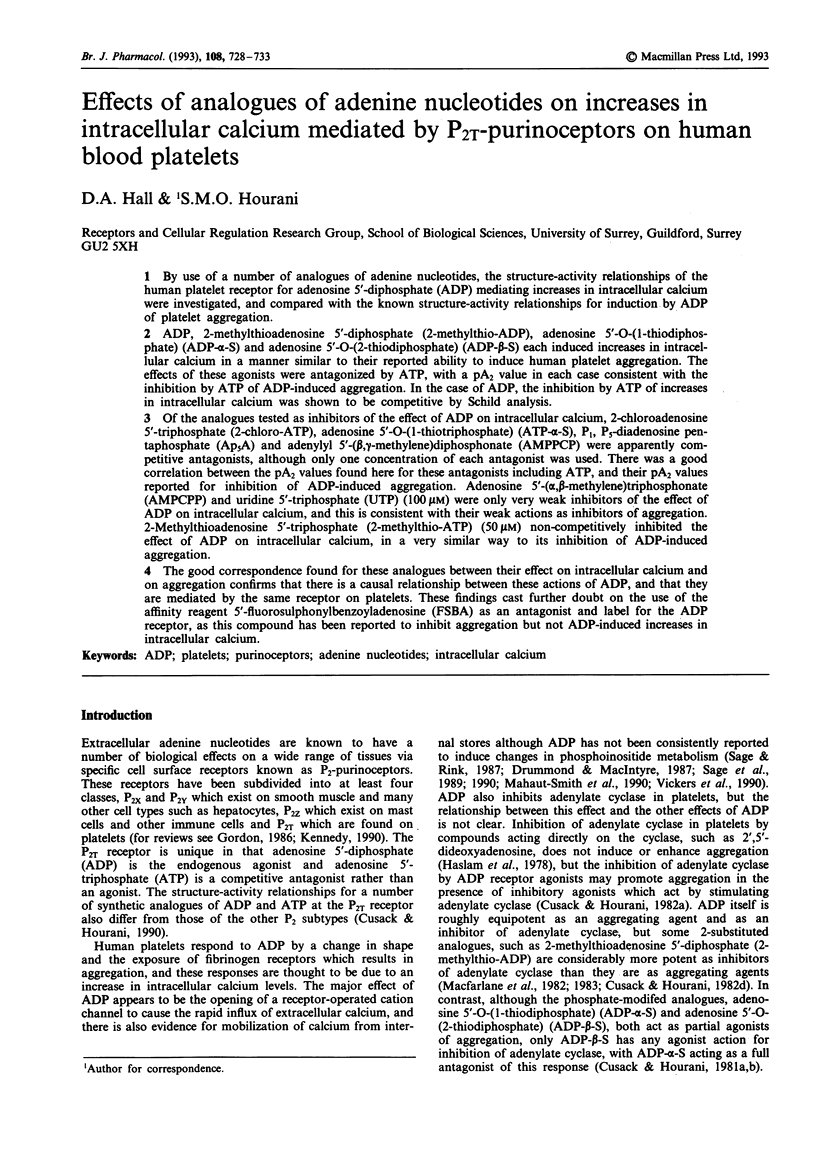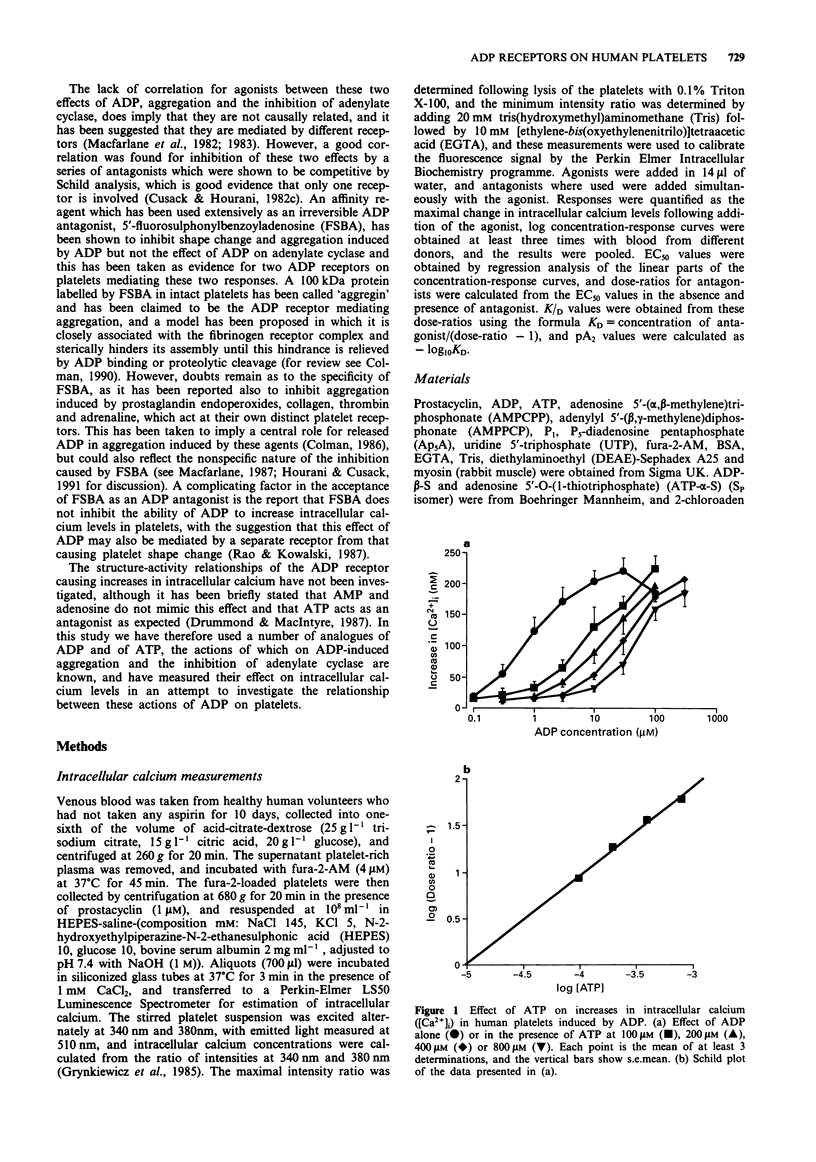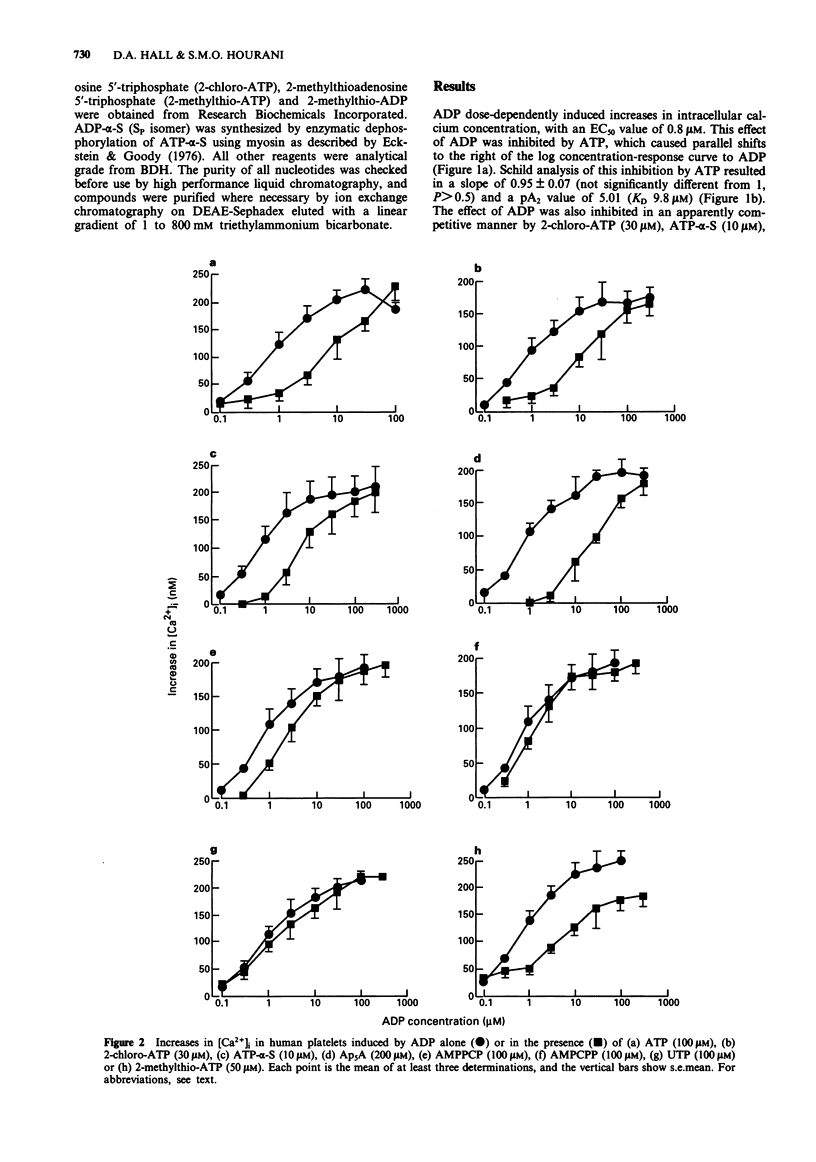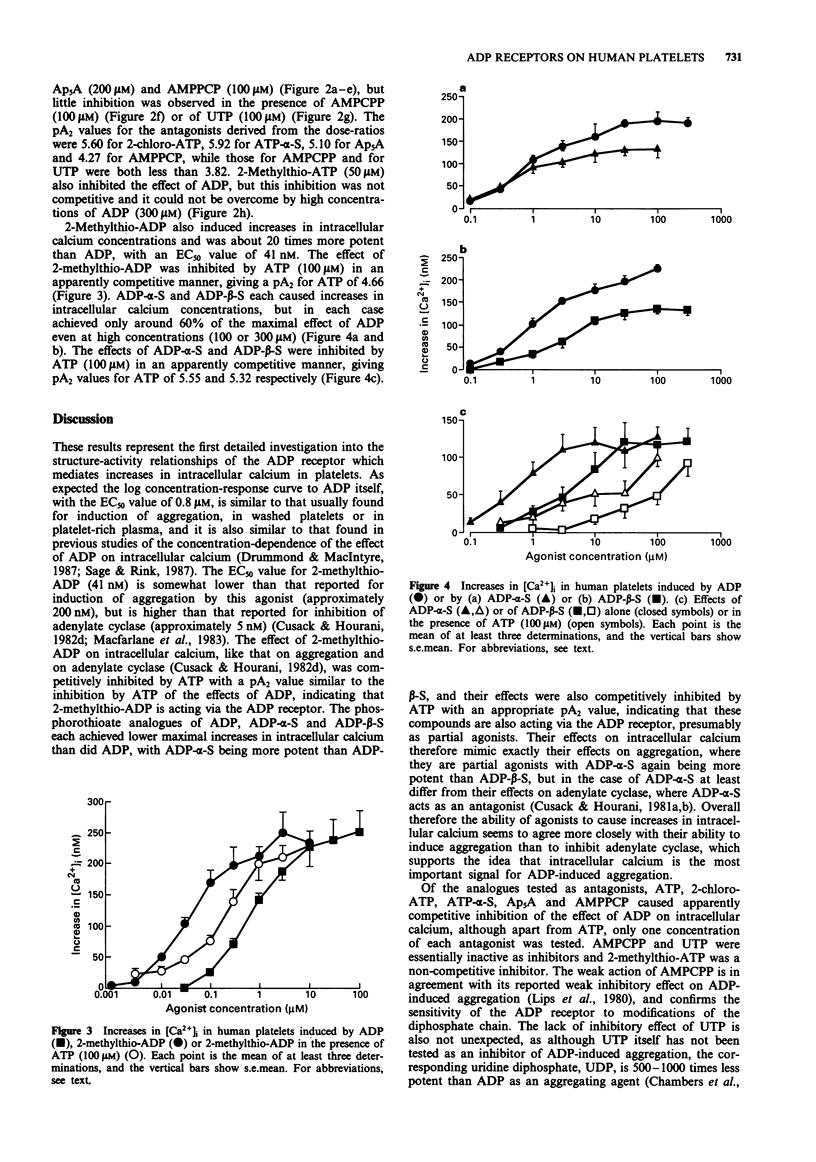Abstract
1. By use of a number of analogues of adenine nucleotides, the structure-activity relationships of the human platelet receptor for adenosine 5'-diphosphate (ADP) mediating increases in intracellular calcium were investigated, and compared with the known structure-activity relationships for induction by ADP of platelet aggregation. 2. ADP, 2-methylthioadenosine 5'-diphosphate (2-methylthio-ADP), adenosine 5'-O-(1-thiodiphosphate) (ADP-alpha-S) and adenosine 5'-O-(2-thiodiphosphate) (ADP-beta-S) each induced increases in intracellular calcium in a manner similar to their reported ability to induce human platelet aggregation. The effects of these agonists were antagonized by ATP, with a pA2 value in each case consistent with the inhibition by ATP of ADP-induced aggregation. In the case of ADP, the inhibition by ATP of increases in intracellular calcium was shown to be competitive by Schild analysis. 3. Of the analogues tested as inhibitors of the effect of ADP on intracellular calcium, 2-chloroadenosine 5'-triphosphate (2-chloro-ATP), adenosine 5'-O-(1-thiotriphosphate) (ATP-alpha-S), P1, P5-diadenosine pentaphosphate (Ap5A) and adenylyl 5'-(beta,gamma-methylene)diphosphonate (AMPPCP) were apparently competitive antagonists, although only one concentration of each antagonist was used. There was a good correlation between the pA2 values found here for these antagonists including ATP, and their pA2 values reported for inhibition of ADP-induced aggregation. Adenosine 5'-(alpha, beta-methylene)triphosphate (AMPCPP) and uridine 5'-triphosphate (UTP) (100 microM) were only very weak inhibitors of the effect of ADP on intracellular calcium, and this is consistent with their weak actions as inhibitors of aggregation.(ABSTRACT TRUNCATED AT 250 WORDS)
Full text
PDF





Selected References
These references are in PubMed. This may not be the complete list of references from this article.
- Colman R. W. Aggregin: a platelet ADP receptor that mediates activation. FASEB J. 1990 Mar;4(5):1425–1435. doi: 10.1096/fasebj.4.5.2407587. [DOI] [PubMed] [Google Scholar]
- Colman R. W. Platelet activation: role of an ADP receptor. Semin Hematol. 1986 Apr;23(2):119–128. [PubMed] [Google Scholar]
- Cusack N. J., Hourani S. M. Adenosine 5-diphosphate antagonists and human platelets: no evidence that aggregation and inhibition of stimulated adenylate cyclase are mediated by different receptors. Br J Pharmacol. 1982 May;76(1):221–227. doi: 10.1111/j.1476-5381.1982.tb09210.x. [DOI] [PMC free article] [PubMed] [Google Scholar]
- Cusack N. J., Hourani S. M. Differential inhibition by adenosine or by prostaglandin E1 of human platelet aggregation induced by adenosine 5'-O-(1-thiodiphosphate) and adenosine 5'-O-(2-thiodiphosphate). Br J Pharmacol. 1982 Feb;75(2):257–259. doi: 10.1111/j.1476-5381.1982.tb08781.x. [DOI] [PMC free article] [PubMed] [Google Scholar]
- Cusack N. J., Hourani S. M. Effects of RP and SP diastereoisomers of adenosine 5'-O-(1-thiodiphosphate) on human platelets. Br J Pharmacol. 1981 Jun;73(2):409–412. doi: 10.1111/j.1476-5381.1981.tb10437.x. [DOI] [PMC free article] [PubMed] [Google Scholar]
- Cusack N. J., Hourani S. M. Partial agonist behaviour of adenosine 5'-O-(2-thiodiphosphate) on human platelets. Br J Pharmacol. 1981 Jun;73(2):405–408. doi: 10.1111/j.1476-5381.1981.tb10436.x. [DOI] [PMC free article] [PubMed] [Google Scholar]
- Cusack N. J., Hourani S. M. Specific but noncompetitive inhibition by 2-alkylthio analogues of adenosine 5'-monophosphate and adenosine 5'-triphosphate of human platelet aggregation induced by adenosine 5'-diphosphate. Br J Pharmacol. 1982 Feb;75(2):397–400. doi: 10.1111/j.1476-5381.1982.tb08800.x. [DOI] [PMC free article] [PubMed] [Google Scholar]
- Cusack N. J., Hourani S. M. Subtypes of P2-purinoceptors. Studies using analogues of ATP. Ann N Y Acad Sci. 1990;603:172–181. doi: 10.1111/j.1749-6632.1990.tb37671.x. [DOI] [PubMed] [Google Scholar]
- Eckstein F., Goody R. S. Synthesis and properties of diastereoisomers of adenosine 5'-(O-1-thiotriphosphate) and adenosine 5'-(O-2-thiotriphosphate). Biochemistry. 1976 Apr 20;15(8):1685–1691. doi: 10.1021/bi00653a015. [DOI] [PubMed] [Google Scholar]
- Gordon J. L. Extracellular ATP: effects, sources and fate. Biochem J. 1986 Jan 15;233(2):309–319. doi: 10.1042/bj2330309. [DOI] [PMC free article] [PubMed] [Google Scholar]
- Greco N. J., Tandon N. N., Jackson B. W., Jamieson G. A. Low structural specificity for nucleoside triphosphates as antagonists of ADP-induced platelet activation. J Biol Chem. 1992 Feb 15;267(5):2966–2970. [PubMed] [Google Scholar]
- Grynkiewicz G., Poenie M., Tsien R. Y. A new generation of Ca2+ indicators with greatly improved fluorescence properties. J Biol Chem. 1985 Mar 25;260(6):3440–3450. [PubMed] [Google Scholar]
- Haslam R. J., Davidson M. M., Desjardins J. V. Inhibition of adenylate cyclase by adenosine analogues in preparations of broken and intact human platelets. Evidence for the unidirectional control of platelet function by cyclic AMP. Biochem J. 1978 Oct 15;176(1):83–95. doi: 10.1042/bj1760083. [DOI] [PMC free article] [PubMed] [Google Scholar]
- Hourani S. M., Cusack N. J. Pharmacological receptors on blood platelets. Pharmacol Rev. 1991 Sep;43(3):243–298. [PubMed] [Google Scholar]
- Kennedy C. P1- and P2-purinoceptor subtypes--an update. Arch Int Pharmacodyn Ther. 1990 Jan-Feb;303:30–50. [PubMed] [Google Scholar]
- Lips J. P., Sixma J. J., Schiphorst M. E. Binding of adenosine diphosphate to human blood platelets and to isolated blood platelet membranes. Biochim Biophys Acta. 1980 Apr 3;628(4):451–467. doi: 10.1016/0304-4165(80)90394-3. [DOI] [PubMed] [Google Scholar]
- Macfarlane D. E., Mills D. C., Srivastava P. C. Binding of 2-azidoadenosine [beta-32P]diphosphate to the receptor on intact human blood platelets which inhibits adenylate cyclase. Biochemistry. 1982 Feb 2;21(3):544–549. doi: 10.1021/bi00532a020. [DOI] [PubMed] [Google Scholar]
- Macfarlane D. E., Srivastava P. C., Mills D. C. 2-Methylthioadenosine[beta-32P]diphosphate. An agonist and radioligand for the receptor that inhibits the accumulation of cyclic AMP in intact blood platelets. J Clin Invest. 1983 Mar;71(3):420–428. doi: 10.1172/JCI110786. [DOI] [PMC free article] [PubMed] [Google Scholar]
- Mahaut-Smith M. P., Sage S. O., Rink T. J. Receptor-activated single channels in intact human platelets. J Biol Chem. 1990 Jun 25;265(18):10479–10483. [PubMed] [Google Scholar]
- O'Connor S. E., Dainty I. A., Leff P. Further subclassification of ATP receptors based on agonist studies. Trends Pharmacol Sci. 1991 Apr;12(4):137–141. doi: 10.1016/0165-6147(91)90530-6. [DOI] [PubMed] [Google Scholar]
- Rao A. K., Kowalska M. A. ADP-induced platelet shape change and mobilization of cytoplasmic ionized calcium are mediated by distinct binding sites on platelets: 5'-p-fluorosulfonylbenzoyladenosine is a weak platelet agonist. Blood. 1987 Sep;70(3):751–756. [PubMed] [Google Scholar]
- Sage S. O., Merritt J. E., Hallam T. J., Rink T. J. Receptor-mediated calcium entry in fura-2-loaded human platelets stimulated with ADP and thrombin. Dual-wavelengths studies with Mn2+. Biochem J. 1989 Mar 15;258(3):923–926. doi: 10.1042/bj2580923. [DOI] [PMC free article] [PubMed] [Google Scholar]
- Sage S. O., Reast R., Rink T. J. ADP evokes biphasic Ca2+ influx in fura-2-loaded human platelets. Evidence for Ca2+ entry regulated by the intracellular Ca2+ store. Biochem J. 1990 Feb 1;265(3):675–680. doi: 10.1042/bj2650675. [DOI] [PMC free article] [PubMed] [Google Scholar]
- Sage S. O., Rink T. J. The kinetics of changes in intracellular calcium concentration in fura-2-loaded human platelets. J Biol Chem. 1987 Dec 5;262(34):16364–16369. [PubMed] [Google Scholar]
- Seifert R., Schultz G. Involvement of pyrimidinoceptors in the regulation of cell functions by uridine and by uracil nucleotides. Trends Pharmacol Sci. 1989 Sep;10(9):365–369. doi: 10.1016/0165-6147(89)90009-6. [DOI] [PubMed] [Google Scholar]
- Vickers J. D., Kinlough-Rathbone R. L., Packham M. A., Mustard J. F. Inositol phospholipid metabolism in human platelets stimulated by ADP. Eur J Biochem. 1990 Oct 24;193(2):521–528. doi: 10.1111/j.1432-1033.1990.tb19367.x. [DOI] [PubMed] [Google Scholar]


